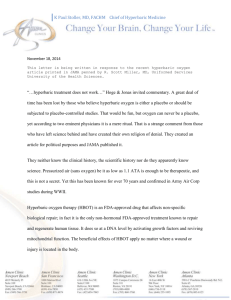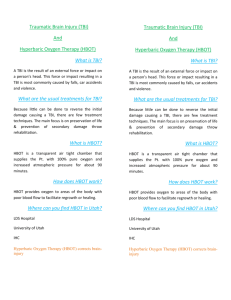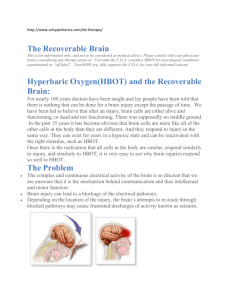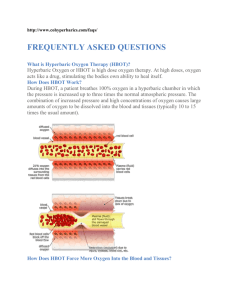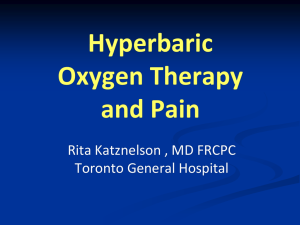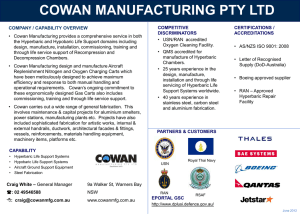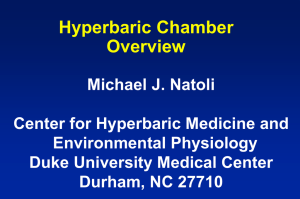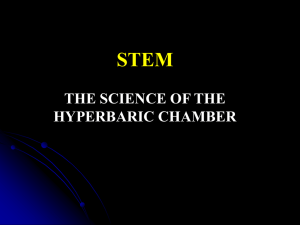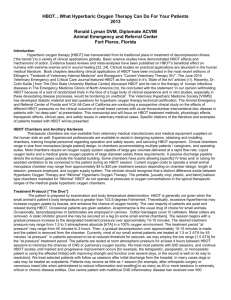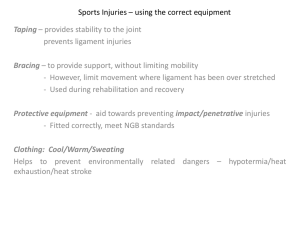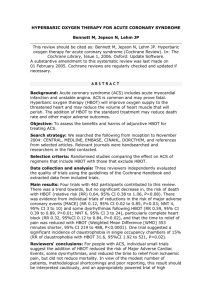Hyperbaric Chambers & Hyperbaric Oxygen Therapy (HBOT)
advertisement
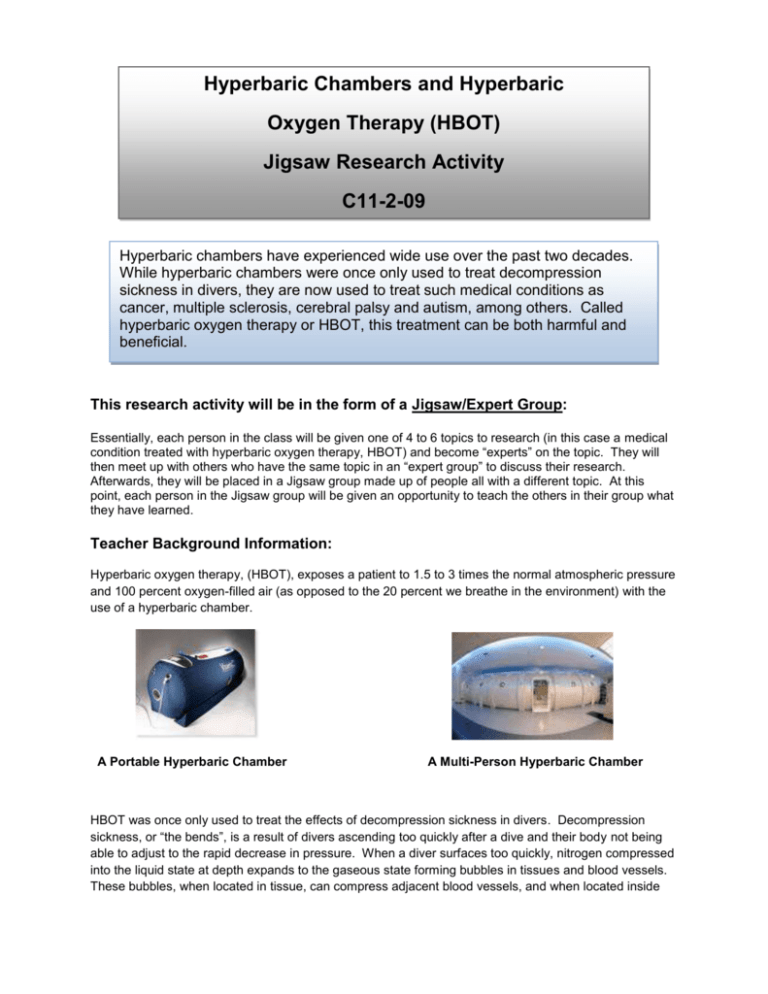
Hyperbaric Chambers and Hyperbaric Oxygen Therapy (HBOT) Jigsaw Research Activity C11-2-09 Hyperbaric chambers have experienced wide use over the past two decades. While hyperbaric chambers were once only used to treat decompression sickness in divers, they are now used to treat such medical conditions as cancer, multiple sclerosis, cerebral palsy and autism, among others. Called hyperbaric oxygen therapy or HBOT, this treatment can be both harmful and beneficial. This research activity will be in the form of a Jigsaw/Expert Group: Essentially, each person in the class will be given one of 4 to 6 topics to research (in this case a medical condition treated with hyperbaric oxygen therapy, HBOT) and become “experts” on the topic. They will then meet up with others who have the same topic in an “expert group” to discuss their research. Afterwards, they will be placed in a Jigsaw group made up of people all with a different topic. At this point, each person in the Jigsaw group will be given an opportunity to teach the others in their group what they have learned. Teacher Background Information: Hyperbaric oxygen therapy, (HBOT), exposes a patient to 1.5 to 3 times the normal atmospheric pressure and 100 percent oxygen-filled air (as opposed to the 20 percent we breathe in the environment) with the use of a hyperbaric chamber. A Portable Hyperbaric Chamber A Multi-Person Hyperbaric Chamber HBOT was once only used to treat the effects of decompression sickness in divers. Decompression sickness, or “the bends”, is a result of divers ascending too quickly after a dive and their body not being able to adjust to the rapid decrease in pressure. When a diver surfaces too quickly, nitrogen compressed into the liquid state at depth expands to the gaseous state forming bubbles in tissues and blood vessels. These bubbles, when located in tissue, can compress adjacent blood vessels, and when located inside blood vessels can block blood flow, resulting in multiple stroke-like manifestations, or even death. In decompression sickness, hyperbaric oxygen forces the nitrogen back into the liquid state and then gradual decompression allows the diver to breathe the nitrogen off as he or she would under normal gradual surfacing conditions. There is one such hyperbaric chamber in Winnipeg located at the Canadian Forces Base, Westwin. Information about the hyperbaric chamber at CFB can be found at their website: http://www.airforce.forces.gc.ca/17wing/squadron/cfssat_e.asp (Note: CFB also has a hypobaric chamber which is used to train pilots with the symptoms of hypoxia. The chamber simulates going from ground level to an altitude of 10,000 m) In addition to treating decompression sickness, HBOT has now been used to treat multiple medical conditions. Conditions that have been treated with HBOT are: Decompression sickness (the bends) Bell’s Palsy Cancer Chronic fatigue syndrome Cerebral edema (swelling of the brain) Migraines Stroke Arthritis Autism Multiple sclerosis Cerebral Palsy Carbon monoxide poisoning Allergies Near drowning Plastic surgery (to accelerate recovery) Smoke inhalation Air or gas embolism Acute traumatic injuries resulting in loss of blood supply to organs Cyanide poisoning Enhancement of healing in selected problem wounds Selected refractory anaerobic infections Exceptional blood loss anemia Gas gangrene Necrotizing soft tissue infections (when tissue is dying) Osteomyelitis (infection of bone) not responding to standard treatment Radiation necrosis (death) of bone and/or soft tissue (e.g. radiation "therapy") Surgical skin grafts or flaps not receiving enough oxygen and in danger of failing Non-radiation burns HBOT is generally used as an adjunctive therapy – meaning it does not compete with or replace other treatment methods. Available scientific evidence does not support the claims that HBOT can treat all of the above medical conditions, although, there are several testimonies from people who have found much success with the treatment for various conditions. Reported Benefits of Hyperbaric Oxygen Therapy: Increases neuronal energy metabolism in the brain Can create sustained cognitive improvement Wakes up sleeping brain cells that are metabolizing enough to stay alive but are not actively "firing" Enhances the body's ability to fight bacterial and viral infections Deactivates toxins and poisons (e.g. side effects from some chemotherapy, spider bites, air pollution, etc.) Enhances wound healing by stimulating the growth of new capillaries into the injured area Creates an immediate aerobic state Removes free radicals Reduces tissue swelling Acts as an anti-inflammatory Complications of HBOT HBOT is a relatively safe method for approved medical treatments. Complications can be reduced if pressures within the hyperbaric chamber remain below 3 times the normal atmospheric pressure and sessions last no longer than two hours. Milder problems associated with HBOT include claustrophobia, fatigue, and headache. More serious complications include myopia (short-sightedness) that can last for weeks or months, sinus damage, ruptured middle ear, and lung damage. A complication called oxygen toxicity can result in seizures, fluid in the lungs, and even respiratory failure. Patients at high risk of oxygen toxicity may be given “air breaks” during which they breathe room air rather than oxygen for short periods during treatment. People with severe congestive heart failure may have their symptoms worsened by HBOT. Patients with certain types of lung disease may be at higher risk of collapsed lung during HBOT. Pregnant women should be treated with HBOT only in serious situations where there are no other options. Hyperbaric oxygen chambers can also be a fire hazard: fires or explosions in hyperbaric chambers have caused about 55 deaths worldwide. Deaths from HBOT: Fire is the most common fatal complication. Over the past 20 years, with millions of compressions in clinical hyperbaric chambers, 55 deaths have been reported. Many were preventable; 35 were in one country and due to inadequate precautions and 10 incidents resulting in 20 deaths occurred when banned substances (including lighted cigarettes) were taken into the chamber. Student Jigsaw Activity: Hyperbaric Chambers and HBOT Hyperbaric chambers have experienced wide use over the past two decades. While hyperbaric chambers were once only used to treat decompression sickness in divers, they are now used to treat such medical conditions as cancer, multiple sclerosis, cerebral palsy and autism, among others. Called hyperbaric oxygen therapy or HBOT, this treatment can be both harmful and beneficial. It will be your task to research a medical condition that can be treated with HBOT and determine the associated uses and risks of HBOT. Prior to the Jigsaw activity, students should access the following information regarding the history of hyperbaric chambers and HBOT so that they have sufficient background information on the topic. **A Brief History of Hyperbaric Oxygen Therapy http://www.hbot4u.com/whatishbot.html Other Informative Websites: The History of Hyperbaric Chambers and Hyperbaric Oxygen Therapy http://inventors.about.com/library/inventors/blhyperbaric.htm HBOT History http://hbot2008.com/hbot_history.php Jigsaw Activity 1. Divide students into 4- to 6-person jigsaw groups (depending on the number of topics used). The groups should be diverse in terms of gender, ethnicity, race, and ability. 2. Divide the topic of study (in this case a medical condition treated with HBOT) into 4- to 6segments. Several online resources are provided. Choose from : HBOT and Stroke HBOT and Cancer HBOT and Autism HBOT and Multiple Sclerosis HBOT and Cerebral Palsy HBOT and Sports Injuries 3. Assign each student in the Jigsaw group to learn one segment. For example, in a class of 30 students, there will be 5 groups of 6 students each. Thus, there will be 5 students learning about “HBOT and Stroke”, and 5 students learning about “HBOT and Cancer” and so on. 4. Give the students time to research their segment (a few days to a week before you want to do the Jigsaw activity). The research focus is outlined below: Research Focus: What is the medical condition using HBOT treatment that you are exploring? What are the benefits and risks of HBOT for this medical condition? What has been the reported effectiveness of HBOT for this medical condition? Organize your information for discussion in the expert groups that follow. 5. Form temporary "expert groups" by having one student from each jigsaw group join other students assigned to the same segment. Give students in these expert groups time to discuss the main points of their segment and to rehearse the presentations they will make to their jigsaw group. The purpose of expert groups: To increase the chances that each report will be accurate, the students doing the research do not immediately take it back to their jigsaw group. Instead, they meet first with students who have the identical assignment (one from each jigsaw group). For example, students assigned to the “HBOT and Stroke” topic meet as a team of specialists, gathering information, becoming experts on their topic, and rehearsing their presentations. We call this the "expert" group. It is particularly useful for students who might have initial difficulty learning or organizing their part of the assignment, for it allows them to hear and rehearse with other "experts." 6. Bring the students back into their jigsaw groups. 7. Ask each student to present her or his segment to the group. Encourage others in the group to ask questions for clarification. Each student can also evaluate the presenter using the rubric that follows. 8. Float from group to group, observing the process. Use the students’ evaluations of each other to assess student performance in this activity. Extension Activities (For Jigsaw Group or Class Discussion): (There are several online resources listed below to assist with the discussions) 1. Briefly outline the historical background about hyperbaric chambers and HBOT. Include its use as a treatment for decompression sickness in SCUBA divers. 2. Discuss the benefits vs. the risks of treatment of decompression sickness with HBOT. 3. Discuss the major medical conditions that have been treated with HBOT. Discuss their successes and failures. 4. One major concern with the use of hyperbaric chambers is the potential of acquiring the condition known as “oxygen toxicity”. Explain what this condition is and what the risk of getting it is from HBOT. 5. Discuss the benefits and risks associated with HBOT treatment. 6. Research at least one other medical condition known to be treated with HBOT that wasn’t covered in the jigsaw activity. 7. Michael Jackson, among other celebrities, have declared HBOT to be the new “fountain of youth”. Comment on the use of this therapy to reverse the aging process. 8. HBOT has been considered as a potential life-saving alternative for those whose religious beliefs prohibit blood transfusions. (It is the red blood cells that transport oxygen so if you are not allowed a blood transfusion, the hyperbaric chamber can supply a lot of oxygen quite rapidly). Comment on the use of HBOT for this purpose. 9. Debate, as a class, whether HBOT treatment should or should not be used for certain medical conditions. 10. Discuss why oxygen gas is used for this therapy, as opposed to, say nitrogen or carbon dioxide or any other gases. (i.e., why is oxygen gas important in the healing process?) Online Resources: A Brief History of Hyperbaric Oxygen Therapy http://www.hbot4u.com/whatishbot.html HBOT History http://hbot2008.com/hbot_history.php The History of Hyperbaric Chambers and Hyperbaric Oxygen Therapy http://inventors.about.com/library/inventors/blhyperbaric.htm Oxygen therapy stirs hopes and concerns http://www.mult-sclerosis.org/news/Jan2000/OxygenTherapyHBOT.html Hyperbaric Oxygen Therapy (HBOT) and Cancer: http://miraclemountain.homestead.com/cancer.html Problems associated with use of the Hyperbaric Chambers in Sports: http://mypage.direct.ca/g/gcramer/hyper.html The Hyperbaric Therapy Center: http://www.hypertc.com/ HBOT and Anti-Aging: http://www.altmd.com/Articles/Hyperbaric-Oxygen-Therapy-HBOT-for-Anti-Aging Video: Mild Hyperbaric Therapy http://www.hypertc.com/videopage.cfm?id=6 Darren Sharper Minnesota Vikings demonstrates his personal HBOT: http://www.hypertc.com/videopage.cfm?id=1 Autism and Hyperbaric Chambers in the News http://www.hypertc.com/videopage.cfm?id=2 Tim Chandler, Cerebral Palsy, Treatment with HBOT http://www.hypertc.com/testimonialpage.cfm?id=1&fulltext=true HBOT Helps MS Patients: http://www.hypertc.com/articlepage.cfm?id=39 HBOT and Stroke: http://www.hypertc.com/articlepage.cfm?id=36 The Story of Grace: HBOT used to treat severe autism in a dying child http://www.ihausa.org/video/montel.html Doctors Question Benefit of Hyperbaric Oxygen Therapy for Autistic Children http://www.hopeformychild.com/ra_autisticchildren.html Hyperbaric Oxygen as a Therapy of Bell's Palsy http://www.hopeformychild.com/ra_bellspalsy.html Treatment of Children's Epilepsy by Hyperbaric Oxygenation: Analysis of 100 Cases http://www.hopeformychild.com/ra_epilepsyanalysis100.html Sample Presentation Rubric: Criteria Levels of Performance 1 2 1. Organization and Clarity: 3 4 The presentation The presentation is unclear in most is clear in some The HBOT-treated medical parts parts but not condition is outlined both clearly overall and orderly. The presentation The presentation is mostly clear and is completely clear orderly in all parts and orderly 2. Content: Content is adequatelyresearched and contains most of the required information The HBOT-treated medical condition studied contains pertinent information 3. Presentation Style: Tone of voice, use of gestures, and level of enthusiasm are convincing to audience. Content is poorly researched and does not contain all required information Content is inadequatelyresearched and only contains some of the required information Few style features Few style features All style features were used; not were used were used, most convincingly convincingly convincingly Content is wellresearched and contains all required information All style features were used convincingly What is the benefit of the Jigsaw/Expert Group Activity? First, it is a very efficient way to learn the material. But even more important, the jigsaw process encourages listening, engagement, and empathy by giving each member of the group an essential part to play in the activity. Group members must work together as a team to accomplish a common goal; each person depends on all the others. No student can succeed completely unless everyone works well together as a team. This "cooperation by design" facilitates interaction among all students in the class, leading them to value each other as contributors to their common task.
